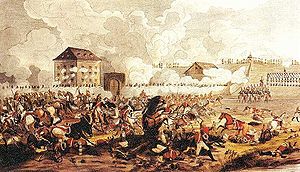
Back Schlacht bei Raab German Bataille de Raab French Győri csata Hungarian Battaglia di Raab Italian Battalia de Raab LMO Bitwa pod Raab Polish Сражение при Раабе Russian Битка код Ђера Serbian Raab Muharebesi Turkish 拉布之战 Chinese
| Battle of Raab | |||||||
|---|---|---|---|---|---|---|---|
| Part of War of the Fifth Coalition | |||||||
 Battle of Raab by Eduard Kaiser | |||||||
| |||||||
| Belligerents | |||||||
|
|
| ||||||
| Commanders and leaders | |||||||
|
|
| ||||||
| Strength | |||||||
|
35,000–40,100[1][2][3] 42 guns[2] |
35,525–40,000[4][1][3] 30 guns[4] | ||||||
| Casualties and losses | |||||||
| 3,000–4,000[5][6][1] | 10,300[7] | ||||||
current battle
Napoleon in command
Napoleon not in command
The Battle of Raab or Battle of Győr (Hungarian: győri csata) was fought on 14 June 1809 during the Napoleonic Wars, between Franco-Italian forces and Habsburg forces. The battle was fought near Győr (Raab in German), Kingdom of Hungary, and ended in a Franco-Italian victory. The victory prevented Archduke John of Austria from bringing any significant force to the Battle of Wagram, while Prince Eugène de Beauharnais's force was able to link up with Emperor Napoleon at Vienna in time to fight at Wagram. Napoleon referred to the battle as "a granddaughter of Marengo and Friedland", as it fell on the anniversary of those two battles.[8]
- ^ a b c d Bodart 1908, p. 407.
- ^ a b Bowden & Tarbox 1980, p. 120.
- ^ a b Gill 2010, p. 81.
- ^ a b Bowden & Tarbox 1980, p. 123.
- ^ Gill 2010, p. 87.
- ^ Smith 1998, p. 315.
- ^ Gill 2010, p. 88.
- ^ Chandler 1979, p. 355.
